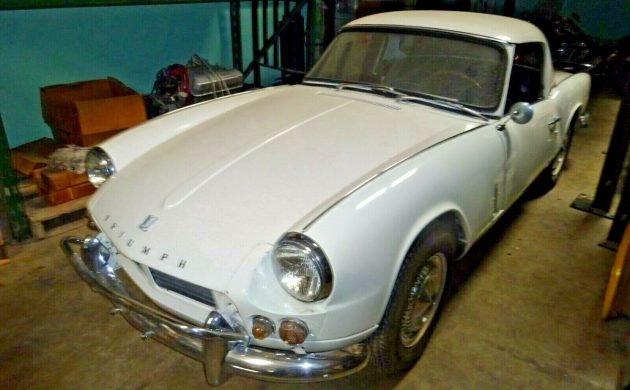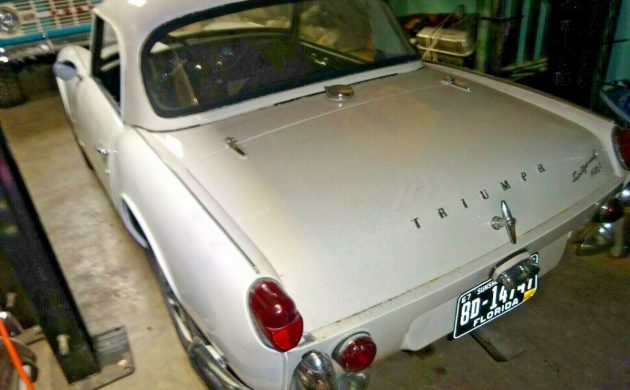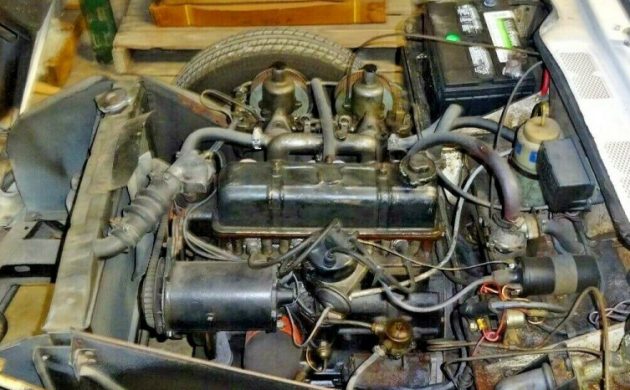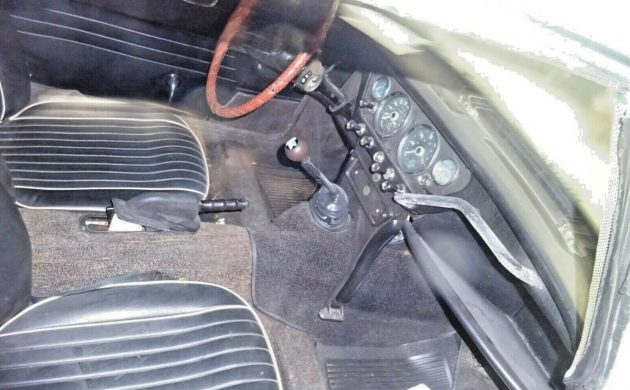For potential owners, each generation of the Triumph Spitfire offered a combination of both advantages and disadvantages when compared to one another. The Mk1 and Mk2 versions featured the purest styling, while the early Mk3s offered the highest levels of performance during the Spitfire’s 18-year total production run. This particular Spitfire is a 1967 Mk 2, and it is a rust-free vehicle that would make a great project for a parent to tackle with their children. It is located in Seminole, Florida, and has been listed for sale here on eBay. Bidding has reached $3,150, and the reserve has been met.
The original design for the Spitfire was penned by Giovanni Michelotti, and many enthusiasts will argue that the styling of the vehicle represents some of his finest work. The swooping lines and delicate bumpers give the Spitfire a light and elegant appearance, which was partially lost in later years with the advent of larger bumpers and other changes that were required to meet tightening safety regulations. This Old English White Spitfire was produced in 1967, and as such, it would have been one of the last to roll off the Canley production line, in Coventry. This is because its successor, the Mk3, was released in March of that year. Looking the car over, it does appear to be complete. For the next owner, the factory hardtop is a nice score, but it isn’t completely clear whether a soft-top is also included. The panels appear to be nice and straight, while the panel gaps are very consistent. The owner claims that the Triumph is rust-free, which means that a light restoration might be all that is required to have the vehicle presenting nicely once again. Of course, if the next owner wanted to undertake a full frame-off restoration, even that isn’t a difficult task. For example, the entire body bolts down to the frame using a total of 12 bolts. This single fact very much typifies the engineering of the Spitfire. It is this simplicity that also helps to make them something of a favorite amongst restorers and enthusiasts. With that in mind, there is some surface corrosion visible in a few locations around the car, so I have to say that I would be very tempted to undertake a full restoration myself.
Triumph was able to produce and sell the Spitfire at a competitive price because it carried over many components from other vehicles in its range. The frame itself was a much-modified version of the one that the Herald was built on, while the mechanical components were also lifted from the same model with very few changes. The 1,147cc 4-cylinder engine from the Herald was breathed upon slightly, with a warmer camshaft and a pair of SU carburetors. This blessed the Spitfire with 67hp and a 0-60 time of around 14 seconds. Hooked to the back of the little four is a 4-speed manual transmission, although an overdrive option was available by the time this car was produced. Suspension and steering were also largely unchanged from the donor model, but the Spitfire did score front disc brakes. Now is where things get a bit vague because it isn’t clear whether the Spitfire runs or drives. The owner does mention the fact that it is fitted with new tires, and while he also refers to a new clutch and master cylinder, it isn’t clear whether these have been fitted, or the parts themselves come as part of the deal. This is because he has mixed this in with information about other parts that will be included in the sale. The vast majority of those parts are items like window seals, but there is a tonneau cover in there somewhere
While there was very little externally to differentiate a Mk1 and a Mk2, inside was a different story. Gone was the Mk1’s rubber floor mats, with molded carpet taking their place. Similarly, the exposed painted surfaces of the Mk1 were now covered, providing a slightly more luxurious feel while adding very little weight. Basically, the interior of this Spitfire looks to be in good condition, with no signs of any rips or tears in the upholstery. The biggest issue is the deterioration of the carpet. However, a full carpet set can be found for around $300. If the next owner fitted this and treated the rest of the interior to a thorough clean, I suspect that it would look pretty nice once again.
With so little power on offer, the Triumph Spitfire Mk2 is by no means a fast car. However, it is a deceptive one. Sitting so close to the road makes people feel like they are traveling significantly faster than the speedometer would otherwise indicate. That also tends to make them quite an enjoyable little car to drive. These are also an incredibly simple vehicle to work on, and parts remain readily available today. That is one of the many reasons why they are popular project cars. The greatest challenge facing anyone who chooses to tackle one of these as a restoration project revolves around potential value. The simple fact is that you can scour the market for some considerable time, and you will be hard-pressed to find a Spitfire with a price in excess of $20,000. In fact, there are plenty of nice examples available for between $12,000 and $15,000. However, if this particular car stays within its current bidding range, and if the next owner can undertake the majority of the restoration work themselves, then this is a project that could make sound economic sense.








Nice looking little car , definitely needs a color change.
I was not aware that O/D was available on these ( since 1963, I read)I’ve never seen one that had it. While I love British cars, I never took a hankerin’ to the newer ones, but quite frankly, I never gave these a chance. Working on them ( the 1500 types) was a pain. I could have “got into” a ’78 1500 for about the same money, and the guy did a lot to it already, but normal bugaboo’s, leaky radiator, key switch worn, no gas gauge, and so on, and I didn’t really like the car. Now these older ones could be pretty cool, and still affordable, parts galore, and while it’s no TR6, it provides the same top down rush, for a lot less. I think it’s a great find.
Pretty and clean older Spitfire!
Had a ‘74 BRG (took the rubber baby buggy bumpers off right away). What a hoot! Going from my beloved and big ‘72 Charger back to a small car (my 1st was a ‘61 Midget) was an education especially with the IRS in the $h!tflame-the rubber boot over the needle bearings tore easily and replacing them though not difficult was annoying. Unlike bobhess’ stepsons car, mine wasn’t especially fiddlily until I put downdraft Weber’s on it and finally sorted them out. The OD was a lesson to in that learning to use it judiciously was the key to its survival and the drivers frustrations with it-that and the headlight switch were the most prominent English car disreputes, but again the fault was that of the Triumph company’s bean counters in contracting with Lucas to build the switchgear to be as close to free as possible-replacement with a better American made switch promptly fixed that issue!
Liked it so much that years after trading it away for a Honda CB 650 (meh), a guy wanted my Honda and offered a 14’ sailboat and a Russet Brown ‘76 Spitfire. As was once said (with apologies to Thomas Wolfe), “you can never go home to your old car again”..well, in this case anyway.
Nice car. Don’t see a lot of the early ones. Agree with the comments on the later cars. My stepson has a 78 and it requires continual fiddling with to keep going. Don’t think I understand why you would change the original color though.
I believe a car like this would benefit from a color with a little more pizzazz, something darker , more elegant. Just my opinion
Oh, to have a bigger garage (and three fewer projects already). This would be a neat companion to my 59 TR3A, same color and all. Unfortunately, the 66 Herald (all the same stuff underneath) 64 AH Sprite and Jamie’s Jamaican are all consuming what space I have, as well as time and Federal stimulus bucks. The temptation is there, and soooooo close by. Of course, if I did buy it, my formerly understanding spouse of 54 years would be managing the estate sale of all of my LBCs. Neat little toy for not much money, with a pretty high fun factor.
Back when I was running a garage, I did a transmission R&R for a fellow who had a GT6+. The directions were to remove the transmission from inside the car. That worked, but ever since then, I have always thought of the doors on these as being about the size of a postage stamp.
I´m just going on feeling, never paid much attention to Spitfires in my young days (not an enthusiasts choice), but this seems to me like an earlier car than ´67. It looks more like what you´d see ´63-65.
Nice basis, hardtop is rare and desirable these days. Don´t change the colour because it´s fine, original and you´d regret it down the line.
This is a nice little Spit.
The top frame is visible, clipped to the boot trim panel behind the fuel tank. The top fabric should be folded and behind the rear cockpit trim panel.
Not an overdrive car from the pics, as there’s no sign of the OD relay where it would be on the firewall/bulkhead in the engine pics.
This looks quite unmolested. The radio blanking plate is still in place, far better than the usual ham-handed efforts to fit a stereo system that one often sees.
Check the forward floors under the carpets. That’s likely the only place one will find corrosion on this one.
A decade ago, I picked up a very similar looking Mk1 in San Diego via eBay, for what I think was about $1 per engine cc of displacement. It was planned to get my son interested in my restoration passion during high school but at the time he was more focused on scouting. He’s now a modern gear head in his own right, tweaking an Abarth to about 230 hp, and I’m finally starting work on the Spit for myself. Have added a hard top and acquired an overdrive, and am looking forward to getting her on the road!
Btw, this is a late Mk2, with chassis number in the 86k range. Mk2’s started at FC50,001 and ended at FC88,904 in January of ‘67.
Share your before and after pix with us, Blackcat, and enjoy the build!
Go Martin! Also would like to see the finished product Blackcat.
I am curious why no one has really mentioned ‘restomod’ on this gem, only mentioning that the ones they owned back in the day were finicky. Is there anything special about the original Triumph Herald power plant that would point to keeping it? Would a Mazda Miyata engine work? Another swap? A big motorcycle engine? Other suggestions? It seems to me a more reliable, peppier engine = more fun.
This guy did it, thought it looks as if there was a fitment issue and he had to cut a hole int eh hood to get the ‘bonnet; to close.
https://forum.miata.net/vb/showthread.php?t=564586
Was a time that we would yank a busted motor from these or newer ones and install a hotter up 13B from a Cosmo or truck, or in one case a nicely built SBC, replete with accompanying drivetrains..
To each their own choice.